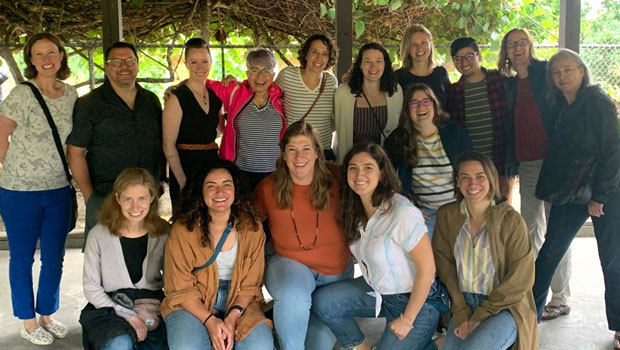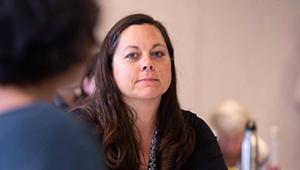Meet KPWHRI’s collaborative scientists

Members of the Kaiser Permanente Health Research Institute Collaborative Science Division at a team gathering
The division contributes to research across the institute with methodological and subject matter expertise
Collaboration is central to research and has always been a guiding force behind the work Kaiser Permanente Washington Health Research Institute (KPWHRI) does to improve health and health care. Members of the new Collaborative Science Division, established in 2022, contribute methodological and subject matter expertise to scientific projects and programs at the institute. Collaborative scientists support project teams to add specialized skills to a study and may also lead grants themselves.
The division includes both master’s- and doctorate-level scientists with a wide range of experience. The creation of the division brought together several existing research and implementation roles to create a larger cohort with more structure and cohesion, and clearer opportunities for career advancement.
“What I love about the collaborative science track here is we’re really free to take our skills and grow them in the direction we want to,” said Mikael Anne Greenwood-Hickman, MPH, a collaborative scientist who joined KPWHRI in 2017. “You don’t have to get a different job to build new partnerships or cross topic areas.”
The position of collaborative scientist is also unique in that it offers researchers a chance to apply advanced expertise and leadership to research studies without requiring them to serve as a principal investigator or develop their own grant funding — although that is an option, too.
“As people grow in the career track, they grow in terms of leadership,” said Claire Allen, MPH, who leads the division with Erin Bowles, MPH, and Katie Coleman, MSPH. “They can choose to lead more of their own work.”
The new division has brought greater connection and peer support among the diverse group of collaborative scientists. The division currently has 21 researchers, 7 who were recruited externally in the last 2 years and 14 who joined from other roles at KPWHRI.
Most collaborative scientists are actively contributing to 3 to 6 projects at any given time, and may be working on a grant proposal, designing elements of a project, analyzing data, writing publications, or figuring out how to implement a new intervention and study how well it works in a health care setting. Members of the division also lead projects of their own. All are expected to apply advanced research and implementation methods in collaboration with project teams.
Connection and teamwork
It’s perhaps unsurprising that a group of scientists dedicated to collaboration would prioritize connection. But the division managers said that the team’s commitment to peer mentoring, sharing advice, and supporting each other has been a hallmark of the past year.
“The camaraderie among the group has been outstanding — it really exceeded our expectations,” Bowles said.
Members of the division consistently emphasized the value of coming together as a team.
“One of the biggest things that is consistent across everyone in the division is a team-oriented approach to doing the work,” said Kelsey Stefanik-Guizlo, MPH, a collaborative scientist who joined KPWHRI about two and a half years ago. “I find collaborative scientists to be just so open, accessible, willing to share information or troubleshoot or offer support. We really hold true to our name in every aspect of the word.”
The creation of the division allowed the group more opportunities to talk through common questions and how their roles fit in with different projects across the institute, she said.
A diverse range of projects and experience
Members of the division came to this work in many different ways.
“I had the opportunity to work with people at the county, people at all different organizations, while I was doing my master’s in public health at the University of Washington,” said Laurel Hansell, MA, MPH, a collaborative scientist who joined KPWHRI in 2018. “And I was always really impressed by the folks here at the institute.”
Hansell has a degree in anthropology, and her experience with qualitative research in that field informed her public health work and continues to play an important role in her work as a collaborative scientist.
“The ability to use both my anthropology and my public health expertise was really, really appealing,” she said. She currently works on multiple research projects, many involving patient and practitioner interviews to help tailor interventions or better understand their experiences.
Kim Arthur, MPH, who joined the institute just over a year ago, also studied anthropology and public health and sees value in the combined experience. Arthur was drawn to the institute because of the opportunity to work on projects that involve collaboration with patients and clinicians. One of her current projects is the ENSPIRE study, which is co-designing materials with people working in long-term care communities to promote the COVID-19 booster.
Greenwood-Hickman uses both qualitative and quantitative methods in her work on studies involving older adults, including a project to culturally adapt a physical activity and sedentary behavior intervention for Latino and Hispanic communities in Southern California.
“Our group has such a wide range of skills and expertise,” she said. “Some folks tend to really focus in a topic area, and others are more focused on a methodology that they apply in lots of different places.”
Stefanik-Guizlo came to KPWHRI with a background in program design, implementation, and evaluation. She previously led programs at nonprofits focused on addressing chronic disease.
“I think that approach has been really helpful in this work because I have a very pragmatic mindset,” she said. “Researchers often need help implementing their findings in a way that meets the need of delivery system partners, and I’m able to bridge those worlds effectively. I was really drawn to the opportunity to be in this role because it satisfies the scientific part of my brain, and also keeps me grounded in the practice piece.”
Benjamin Balderson, PhD, joined the institute 22 years ago, right after finishing his residency as a clinical psychologist. He splits his time between conducting research, primarily leading randomized controlled trials in behavioral medicine, and providing direct care to patients in the Kaiser Permanente Washington Mental Health and Wellness department. Like many other collaborative scientists, he also lends his expertise to committees that develop or update clinical guidelines, both at the national and local level.
“I think you see a lot of diversity of work among the collaborative scientists,” he said. “People are supporting research and also doing local and national service work, participating in trainings, teaching.”
Planning for the future
A consistent theme across the past year, said Allen, has been teambuilding within the division. “Now people want to build more connections across divisions,” she said. “That’s a big goal for the coming year. Figuring out how to network across divisions is particularly important as many of us continue to work in a mostly remote environment.”
Another big goal is actively supporting collaborative scientists in new leadership roles through a series of cross-divisional trainings at KPWHRI.
“Some folks see the collaborative science role as a stepping stone before transitioning to an investigator role, and others see it as a long-term career. It’s both. And it’s important to maintain that flexibility while providing training to our entire division regardless of individual career goals because our group’s responsibilities keep growing. It’s a really relevant and important role,” said Bowles.
By Amelia Apfel
News

Toolkit offers guidance for people with persistent pain
The new comprehensive resource was written from the perspective of patients experiencing ongoing pain.
New funding

KPWHRI to launch study on vaccine hesitancy among long-term care workers
The Patient-Centered Outcomes Research Institute plans to award $4.75 million to compare ways to raise COVID-19 immunization rates.
Prescription overload

Deprescribing: Less may be more
Dr. Sascha Dublin explains why sometimes not taking medications may be a safer and healthier choice.


